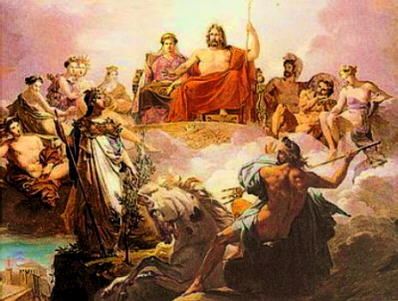The identification of Thrice-Hero (Tris-Heros) is a point of discussion. This name was found twice in the tablets with the Linear Script B from Pylos. Thrice-Hero was mentioned together with the other gods on the human-sacrifice tablet and the name appeared also in context with the offerings of a golden vessel and perfumed oil. It means, that Trice-Hero was worshipped during the Mycenaean time as a local deity in Pylos and offerings were brought to his honor. The cult of heroes was common in the Greek world. There was a supposition that this worshipping started from the Mycenaean cult of dead and from there that it came directly into the Archaic Greek religion (Nilsson).
According to another theory the worship of heroes derived much more later from the influence of the eight century-epic poetry (Burkert). But the name of Thrice-Hero in the Linear Script B and the offerings giving to him are some proves, that the roots of the hero-cult reached until the Mycenaean time. The cult of this hero was performed to honor some important deceased person, who was worshipped as a half-god (or demi-god). The rites were attended in a developed stage by the blood-sacrifices, by food and libations-offerings, as well as by a preparation of a bath and also by a weeping-acts and lamentations.
We are not sure what exactly could mean the name of Tris-Heros. E. Vermeule noted, that this name, which has no good classical counterpart, could mention the Great Hero – Triple Great. She was probably right with this characterization, because the number three played an important role in the old European thoughts, symbolizing the infinity, the perfection, power and greatness. The ancient authors used the names “Trikeraton”, “Trikefalon” or “Trigaranus”, which meant always the same – the three-headed. The three heads or three bodies had to underline some universal capability of its representative. The three-headed creature was used in the Greek mythical imaginary and it was also known from the European thoughts (especially from the Celtic iconography).
There is an idea, that from the form Trigaranus the name Geryones appeared. According to the myths Geryones was the three-headed and three-bodied giant with six hands, the strongest man. Heracles fought him, when one of his arrows pierced all of his bodies. The fight between them was depicted in a frieze of the Corinthian pyxis as soon as in 675-650 BCE ( today this vase is in the collection of the British Museum in London). The three-bodied figure was also presented on a pediment of the Old Temple of Athena on the Acropolis of Athens. The creature, dated around the half of the 6th century BCE., was sculptured as a three-headed and three-bodied winged monster with serpents’ tails, holding some symbols in its hands. The small snakes were attached to the shoulders and arms of the figure. The creature is usually identified as Nereus, sometimes also as Typhon, but there are some doubts about these identifications and the idea of some symbolic significance of this three-headed figure.
This is difficult to prove, if there is some connection between these images and the Thrice-Hero, who was without any doubt a representation of the hero-cult in the Pylos-Palace. The existence of such cult was an important thing in every region. The power of a local hero was felt only indirectly, but the consensus connected to a hero influenced the life of the whole local community – their crops, the health of their families, of their children and of their animals too. For this reason the hero was worshipped as a half-god in every region and the first libation after the gods was donated to their heroes.
References used for the Thrice-Hero-article:
- J.Boardman: Greek Sculpture. London 1993;
- W.Burkert: Greek Religion. Harvard, 1994, 203;
- G. Dontas: The Acropolis and its Museum. Athens 1990, 76;
- Hesiodos: Theogonia. 287,981;
- J.Chadwick: The Mycenaean World. Cambridge 1994, 94, 97;
- C.Kerenyi: The Gods of the Greeks. New York 1992, 45;
- M.P. Nilsson: The Minoan-Mycenaean Religion and its survival in Greek Religion. Lund 1950. Pausanias IV, 36, 3;
- E. Vermeule: Greece in the Bronze Age. Chicago (London), 1964 (1972), 294.
Source: http://www.pantheon.org/

 by Dr Alena Trckova-Flamee, Ph.D.
by Dr Alena Trckova-Flamee, Ph.D.




























